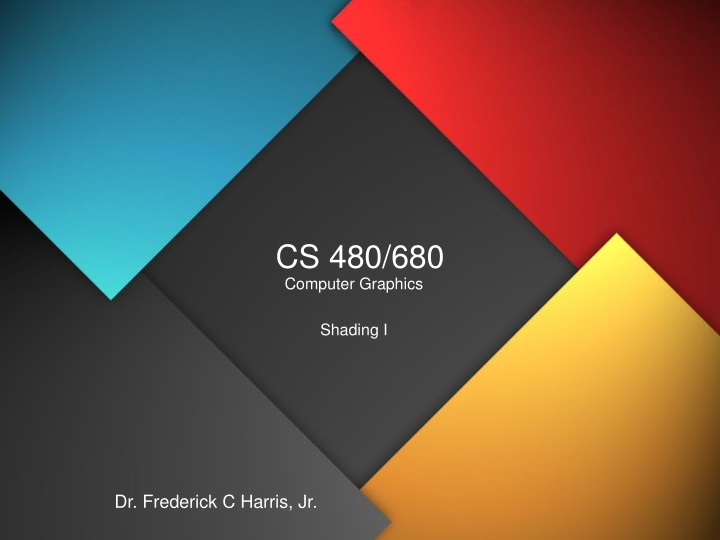
Computer Graphics Shading Fundamentals with Dr. Frederick C. Harris, Jr.
Explore the principles of shading in computer graphics, learn about light-material interactions, the Phong reflection model, and the importance of shading for creating realistic 3D images. Understand the concepts of global and local rendering to achieve realistic lighting effects in real-time graphics.
Download Presentation

Please find below an Image/Link to download the presentation.
The content on the website is provided AS IS for your information and personal use only. It may not be sold, licensed, or shared on other websites without obtaining consent from the author. If you encounter any issues during the download, it is possible that the publisher has removed the file from their server.
You are allowed to download the files provided on this website for personal or commercial use, subject to the condition that they are used lawfully. All files are the property of their respective owners.
The content on the website is provided AS IS for your information and personal use only. It may not be sold, licensed, or shared on other websites without obtaining consent from the author.
E N D
Presentation Transcript
CS 480/680 Computer Graphics Shading I Dr. Frederick C Harris, Jr.
Objectives Learn to shade objects so their images appear three-dimensional Introduce the types of light-material interactions Build a simple reflection model---the Phong model--- that can be used with real time graphics hardware
Why we need shading Suppose we build a model of a sphere using many polygons and color it with a single color. We get something like But we want
Shading Why does the image of a real sphere look like Light-material interactions cause each point to have a different color or shade Need to consider Light sources Material properties Location of viewer Surface orientation
Scattering Light strikes A Some scattered Some absorbed Some of scattered light strikes B Some scattered Some absorbed Some of this scattered light strikes A and so on
Rendering Equation The infinite scattering and absorption of light can be described by the rendering equation Cannotbesolved in general Ray tracing is a special case for perfectly reflecting surfaces Rendering equation is global and includes Shadows Multiple scattering from object to object
Global Effects shadow multiple reflection translucent surface
Local vs Global Rendering Correct shading requires a global calculation involving all objects and light sources Incompatible with pipeline model which shades each polygon independently (local rendering) However, in computer graphics, especially real time graphics, we are happy if things look right There exist many techniques for approximating global effects
Light-Material Interaction Light that strikes an object is partially absorbed and partially scattered (reflected) The amount reflected determines the color and brightness of the object A surface appears red under white light because the red component of the light is reflected and the rest is absorbed The reflected light is scattered in a manner that depends on the smoothness and orientation of the surface
Light Sources General light sources are difficult to work with because we must integrate light coming from all points on the source
Simple Light Sources Point source Model with position and color Distant source = infinite distance away (parallel) Spotlight Restrict light from ideal point source Ambient light Same amount of light everywhere in scene Can model contribution of many sources and reflecting surfaces
Surface Types The smoother a surface, the more reflected light is concentrated in the direction a perfect mirror would reflected the light A very rough surface scatters light in all directions rough surface smooth surface
Phong Model A simple model that can be computed rapidly Has three components Diffuse Specular Ambient Uses four vectors To source To viewer Normal Perfect reflector
Ideal Reflector Normal is determined by local orientation Angle of incidence = angle of relection The three vectors must be coplanar r = 2 (l n ) n - l
Lambertian Surface Perfectly diffuse reflector Light scattered equally in all directions Amount of light reflected is proportional to the vertical component of incoming light reflected light ~cos i cos i = l n if vectors normalized There are also three coefficients, kr, kb, kg that show how much of each color component is reflected
Specular Surfaces Most surfaces are neither ideal diffusers nor perfectly specular (ideal reflectors) Smooth surfaces show specular highlights due to incoming light being reflected in directions concentrated close to the direction of a perfect reflection specular highlight
Modeling Specular Relections Phong proposed using a term that dropped off as the angle between the viewer and the ideal reflection increased Ir ~ ksI cos shininess coef incoming intensity reflected intensity absorption coef
The Shininess Coefficient Values of between 100 and 200 correspond to metals Values between 5 and 10 give surface that look like plastic cos -90 90








